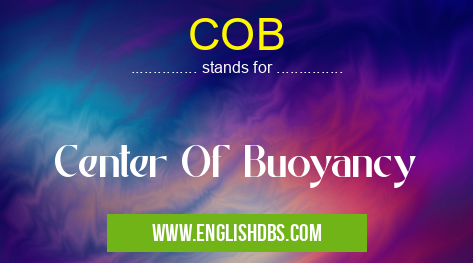What does COB mean in UNCLASSIFIED
COB (Center Of Buoyancy) is a crucial concept in fluid dynamics, particularly in relation to objects floating in or submerged in fluids. It plays a significant role in determining the stability, equilibrium, and buoyancy of an object within a fluid medium.

COB meaning in Unclassified in Miscellaneous
COB mostly used in an acronym Unclassified in Category Miscellaneous that means Center Of Buoyancy
Shorthand: COB,
Full Form: Center Of Buoyancy
For more information of "Center Of Buoyancy", see the section below.
Definition
- COB is the hypothetical point within an object that represents the center of the upward buoyant force exerted by the fluid on the object. This force opposes the weight of the object and keeps it afloat or suspended in the fluid.
Characteristics of COB
- Location: COB is located at the geometric center of the volume of the displaced fluid by the object.
- Direction: COB exerts an upward force that is directly proportional to the volume of the displaced fluid and the density of the fluid.
- Stability: The location of COB relative to the Center of Gravity (COG) of the object determines its stability. When COB is located above COG, the object is considered stable and will return to its equilibrium position if disturbed. In contrast, if COB is below COG, the object is unstable and will topple over.
Applications of COB
- Ship Design: In shipbuilding, COB is crucial for ensuring the stability and safety of vessels. By carefully designing the shape and distribution of the ship's volume, engineers can ensure that COB is located above COG, providing the ship with inherent stability.
- Buoyancy Devices: Life vests and other buoyancy aids are designed with COB strategically positioned to keep the wearer afloat and stable in the water.
- Submarine Design: In submarines, COB is controlled through the use of ballast tanks to adjust the volume of displaced water and maintain the desired buoyancy characteristics.
Essential Questions and Answers on Center Of Buoyancy in "MISCELLANEOUS»UNFILED"
What is COB (Center of Buoyancy)?
COB (Center of Buoyancy) is the point where the upward force of buoyancy acts on a submerged or floating object. It is the centroid of the displaced volume of fluid.
How do you determine the COB of an object?
The COB can be determined experimentally by suspending the object in a fluid and measuring the center of the displaced volume. It can also be calculated theoretically based on the shape and density of the object.
Why is the COB important?
The COB is crucial because it determines the stability of an object floating in a fluid. If the COB is above the center of gravity (COG), the object will be stable and return to its equilibrium position when disturbed. Conversely, if the COB is below the COG, the object will be unstable and capsize.
How does the shape of an object affect its COB?
The shape of an object influences the distribution of buoyancy forces and hence its COB. For example, a sphere has a COB at its center, while an elongated object like a boat has a COB towards its wider end.
Can the COB change for the same object?
Yes, the COB can change depending on the fluid in which the object is submerged. This is because different fluids exert different buoyant forces, altering the center of the displaced volume.
Final Words: COB is a fundamental concept in fluid dynamics that describes the location of the upward buoyant force acting on an object in a fluid. Understanding COB is critical for designing and analyzing objects that interact with fluids, ensuring their stability, equilibrium, and performance. By considering the location of COB relative to COG, engineers can optimize the behavior of objects in fluid environments, such as ships, buoyancy aids, and submarines.
